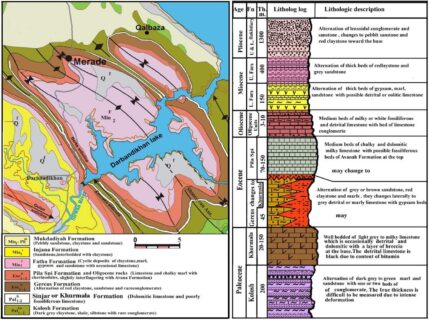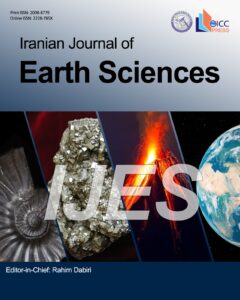Evaluation of the ability of rock (soft) dispersion at the basement of the Darbandikhan Dam’s reservoir, NE Iraq, with a new investigation and Crumb test
Authors
Abstract
The Darbandikhan Dam reservoir in NE Iraq is located on soft sedimentary rocks which sporadically were affected by erosion. The basement rocks include sandstone, siltstone, and claystone, and mineralogically comprise quartz, and feldspar with some lithic fragments that are distributed in a soft matrix. The scanning electron microscope (SEM) images show sheet layers with clay structures for the matrix which is confirm by Semi-quantitative analyses of the EDAX data. The results demonstrate that samples categorize as dispersive soil based on the crumb test (ASTM D 6572–21). The Crumb tests were done in six hours, and the short duration can be considered as a defect. In this research the test time was extended and the behavior of the samples was investigated up to 7 days in intervals of two minutes, one hour, 6, 24, 72 hours, and 7 days. The results indicated that some samples which didn’t show any sign of dispersion in standard duration underwent some kind of egg-shaped erosion after 72 hours, which completely were separated in 7 days, so it would perhaps be better to make modifications to the crumb test. Correspondingly, the Sodium Absorption Ratio (SAR) and Exchangeable Sodium Percentage (ESP) results of soft grain units demonstrated that these units are mainly dispersive.
Graphical Abstract
Keywords
References
A Dutt, MS Saini, TN Singh, AK Verma, RK Bajpai (2016) Analysis of thermo-hydrologic-mechanical impact of repository for high-level radioactive waste in clay host formation: an Indian reference disposal system, Environmental Earth Sciences 66 (8), 2327-2341 DOI: 10.1007/s12665-011-1455-4
Abbasi N, Farjad A, Sepehri S (2017) The use of nanoclay particles for stabilization of dispersive clayey soils, Geotech. Geol. Eng. 36: 327–335. DOI: 10.1007/s10706-017-0330-9
Abbasi N and Nazifi MH (2013) Assessment and modification of Sherard chemical method for evaluation of dispersion potential of soils, Geotechnical and Geological Engineering 31(1):337-346. DOI 10.1007/s10706-012-9573-7
Abbasi N (2011) The role of anions in dispersion potential of clayey soil, Journal of agricultural engineering research 12, No.3, IAERI, 15-30. https://dx.doi.org/10.22092/aridse.2011.102252
ASTM International (2021) Standard Test Method for Particle-Size Distribution (Gradation) of Fine-Grained Soils Using the Sedimentation (Hydrometer) Analysis, ASTM D 7928 - 21 , Annual Book of ASTM Standards Volume: 04.09.
DOI: 10.1520/D7928-21E01
ASTM International (2021) Standard Test Methods for Determining Dispersive Characteristics of Clayey Soils by the Crumb Test, ASTM D 6572 – 21. Annual Book of ASTM Standards Volume: 04.09.
DOI: 10.1520/D6572-21
B Kumar, AK Verma, RK Bajpai, TN Singh (2022), Numerical analysis of heat dissipation through granite and clay in the multi-barrier system of a geological disposal facility, CURRENT SCIENCE 122 (9), 1089 DOI: 10.18520/cs/v122/i9/1089-1093
Goodarzi AR and Salimi M (2015) Stabilization treatment of a dispersive clayey soil using granulated blast furnace slag and basic oxygen furnace slag, Applied Clay Science 108: 61-69. https://doi.org/10.1016/j.clay.2015.02.024
Heinzen RT and Arulanandan K (1977) Factors influencing dispersive clays and methods of identification, Dispersive clays, related piping, and erosion in geotechnical projects, ASTM Special Technical Publication 623: 202-217.
Holmgren GGS and Flanagan CP (1977) Factors affecting spontaneous dispersion of soil materials as evidenced by the crumb test, Dispersive Clays, Related Piping, and Erosion in Geotechnical Projects, ASTM STP 623: 218-239.
Indraratna B, Nutalaya P and Kuganenthira N (1991) Stabilization of a dispersive soil by blending with fly ash, Quarterly Journal of Engineering Geology and Hydrogeology 24(3): pp.275-290. https://doi.org/10.1144/GSL.QJEG.1991.024.03.03
IRCOLD (1996) assessment and application of dispersive soils in earth dams, Iranian national Committee on Large Dams, pub. No. 8.
Mitchell JK and Soga K (2005) Fundamentals of soil behavior (Vol. 3, p. USA), New York: John Wiley & Sons.
Ouhadi VR and Goodarzi AR (2006) Assessment of the stability of a dispersive soil treated by alum, Engineering geology 85(1-2): 91-101. https://doi.org/10.1016/j.enggeo.2005.09.042
Rahimi H and Abbasi N (2019) Geotechnical engineering of problematic soils, university of tehran press, 4th edition, 848.
Savaş H (2016) Consolidation and swell characteristics of dispersive soils stabilized with lime and natural zeolite, Science and Engineering of Composite Materials 23(6):589-598. DOI 10.1515/secm-2014-0202
Sayehvand S and Dehghani M (2014) Identification and management of dispersive soils, Electron J Geotech Eng 19: 9023-9032.
Sherard JL, Dunnigan LP, and Decker RS (1976) Identification and nature of dispersive soils, Journal of the Geotechnical Engineering Division, 102(4): 287-301.
Singh B, Gahlot P, and Purohit DGM, (2018) Dispersive soils-characterization, problems and remedies, Int. Res. J. Eng. Technol 5(6): 2478-2484.
Sissakian VK and Fouad SF (2014) Geological Map of Sulaimaniyah Quadrangle, scale 1: 250 000, Iraq Geological Survey Publications, Baghdad, Iraq.
Umesh T, Dinesh S and Sivapullaiah PV (2011) Characterization of dispersive soils, Materials Sciences and Applications 2(6): 629-633. DOI: 10.4236/msa.2011.26085.
Umesha TS, Dinesh SV and Sivapullaiah PV (2009) Control of dispersivity of soil using lime and cement, International journal of geology 3(1): 8-16.
Wan CF and Fell R (2004) Investigation of rate of erosion of soils in embankment dams, Journal of geotechnical and geoenvironmental engineering 130(4): 373-380. https://doi.org/10.1061/ (ASCE) 1090-0241(2004)130:4(373)
Yang CJ, Yeh LW, Cheng YC, Jen CH and Lin JC (2019) Badland erosion and its morphometric features in the tropical monsoon area, Remote Sensing 11(24), p.3051. Doi: 10.3390/rs11243051.
Yong RN, Warkentin BP (1996) Introduction to soil behavior, MacMillan, New York, pp. 451.





